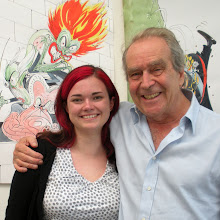So with all my continued talk of my book and trying to get it published, I thought I should do a little overview of the process of sending it to publishers…you know, in the off chance someone out there may find the information helpful. There’s actually a lot that goes into submitting a project to a publisher, and while it’s a lot of work, it’s definitely worth while and a great learning experience. Since there’s so much info, I’m splitting it up into two posts. This will cover researching publishers/submitting your project, while the next will cover putting together your sample dummy book.
So, you’ve written and illustrated a book and you want to get it published… Before you submit your work to a publisher you have to have a publisher (or several) to actually submit it to. How do you go about this? Well, there are several avenues you can take. A couple of great resources I have found are the Children’s Writer’s and Illustrator’s Market (US-based) and Children’s Writers’ and Artists’ Yearbook (UK-based). Both have a selection of children’s book publishers (as well as other markets for children’s illustration) as well as tips on what publishers look for, and how to write for the children’s market. Each give a rundown on what kind of books each publisher publishes, such as fiction, non-fiction, novelty books, young adult, etc. Both are valuable books to have in your illustration library, plus they’re reasonably priced and available from Amazon. However, if you want that whole “try before you buy” thing you can always head to Borders or Barnes and Noble and have a look through while enjoying a half double decaf decaffeinated half-caf (with a twist of lemon).
As you’re flipping through Market and/or Yearbook, look for publishers that would be interested in what you’re writing. For example, since my piece is a picture book for a younger audience, I wouldn’t send it to a publisher that only publishes education-based material. If you submit your work to a publisher that doesn’t publish your genre, it makes you look unprofessional--don’t waste your or the editor’s time. Just do your research. Another thing to look for in publishers are ones that are open to submissions. A lot of the big publishing houses do not accept unsolicited manuscripts or work that isn’t being submitted by a literary agent. Trust me, reading the phrase “we do not accept unsolicited submissions” will get to you, but just keep researching. There ARE publishers that love to get submissions from up and coming authors and illustrators, so don’t get caught up in the ones that won’t look at your book.
When you’ve come up with a list of publishers to submit to, it’s time to get your submission all together. You’ll want to write a cover letter outlining your book, the audience it’s best for, and your credentials as a writer/illustrator. It shouldn’t be more than a page, much like a cover letter you would submit to a potential employer. You’ll also want to include the manuscript of your book, and a dummy book to give the publisher an idea of the pacing and layout, as well as your illustration style (I’ll write more on the dummy book in my next post). If the publisher returns submissions (in the event they reject your submission), include a self addressed stamped envelope so you can get your dummy book back. Put everything in a nice, professional looking folder and package it so that it will arrive undamaged. I also recommend including a business card, promotional mailer, or both that the publisher can keep so they have your contact information on file. The presentation folders I have been using come with a space for you to put a business card on the front cover; I like them a lot because it means the publisher knows my name before opening the folder.
Once you’ve got all this together you’re ready to go! Pop it in the post and get ready to wait a minimum of 3 months for a response. Don’t be too surprised or disappointed if you get a rejection…it’s just the way the business works, and seemingly more so nowadays with the poor global economy. Just stick with it and give it your all…and good luck!
Up next I’ll have a post on putting together a dummy book using Lulu.com.
Subscribe to:
Post Comments (Atom)



No comments:
Post a Comment